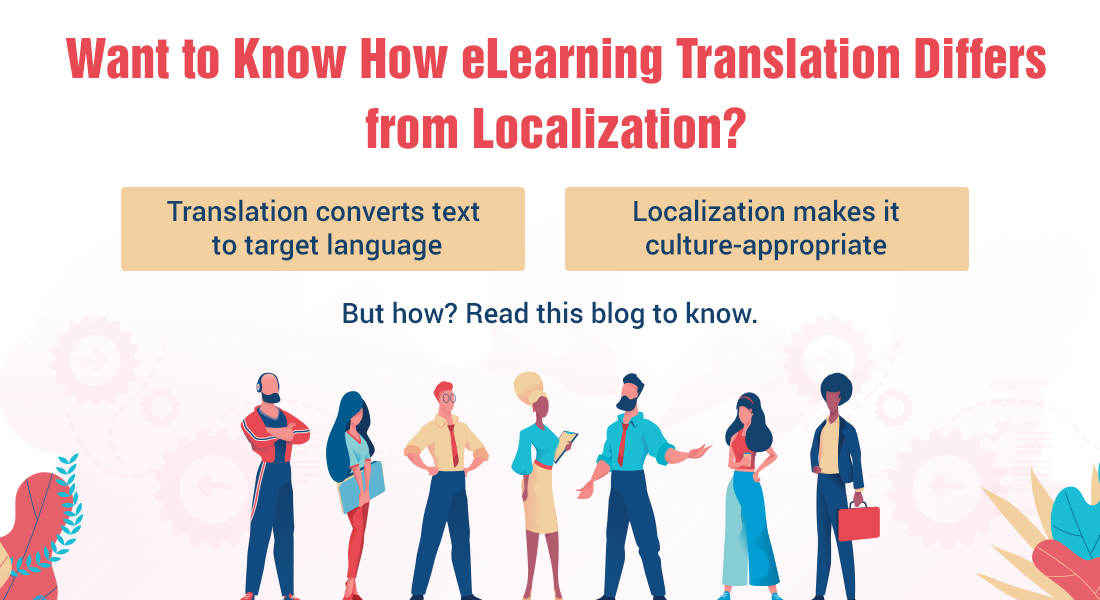Training Global Audiences: Why Just Translation is Not Enough

Providing online corporate training for a large pool of global learners can get tricky. You know what language they speak, so you know into which languages the eLearning course must be translated into. But is it enough to just change the language of your eLearning course to train your global learners? What about the very specific cultural nuances of the target audiences?
Sure eLearning translation converts the source language of the courses into the target language, but it cannot convey the culture specific meanings of the source language. That is where eLearning localization comes into play.
Want to design courses that will make learning stick to your learners? Click here.
Translation and localization are different from each other, although they are related. While translation is only concerned with converting the text from one language to another, localization will make the course ‘native’.
I know it is confusing, but please bear with me as I try to explain the differences between translation and localization, and how both are critical for global corporate training.
E-learning Translation Vs E-learning Localization: Know it Here
E-learning Localization Varies from E-learning Translation in Two Areas
1. Overall GUI
Colors, on-screen texts, icons, characters and avatars, need to be made specific to the target culture.
2. E-learning Course Elements
- Translate and localize text
- Localize images and videos
- Set appropriate tone for audio and narration
- Localize scenarios, stories, interactivities and games
Translation vs Localization: What’s the difference?
Put simply, translation is the process of changing the language of a source text to a target language so that the meaning of the source text is carried over to the target language.
Localization, on the other hand, is concerned less with the language and more with making the content feel closest to the target culture. That means not just the text, but also images, storylines, characters or avatars, etc., need to be ‘localized’ to make them feel more ‘native’.
Take a look at this example.
People from both Mexico and Spain speak Spanish, yet there are differences in the way they speak/use Spanish. While translating a text having the word ‘pen’ in it, from English to Spanish and English to Mexican Spanish, the word will change to ‘bolígrafo’ (Spanish for pen) for both.
But the same word ‘pen’ will be localized to ‘pluma’ for Mexican Spanish learners for them to connect better with the text. It is the same as Americans being comfortable with ‘colors’ but the British finding ‘colours’ more appropriate.
If I were to explain this in one line, translation converts the language from one to another keeping the meaning intact, and localization converts the cultural element of a text from one culture to another, modifying the meaning slightly wherever required.
The influence of culture on instructional design is something we all tend to miss, but is quite important.
Why Translate AND Localize?
eLearning translation services are used by global organizations for their training requirements keeping two specific things in mind:
- Although global employees may understand English (and may be good in it), they cannot be expected to get the specific culture nuances of the English language.
- During remote training in times of COVID-19 (and non COVID-19 situations as well), remote learners cannot clarify their doubts from a native speaker.
That is why eLearning localization is as important as eLearning translation – to make ‘other than English speaking’ learners feel comfortable with their training and understand all information the best they can. It is important that learners all over the world understand exactly what they are being trained on to ensure the best performance and increase training ROI.
E-learning Translation vs. E-learning Localization – Things to Remember
Here is a short list of things you have to remember about eLearning translation and eLearning localization. We have to keep in mind that eLearning localization is about adapting the text to match the culture and social norms of the target audience.
1. Overall Graphical User Interface (GUI)
E-learning localization ensures that the GUI of the course upon being accessed does not clash with the learner’s culture. It should be warm and welcoming and not overwhelmingly foreign for computer screens or mobile learning courses.
Here, translation is only limited to converting on-screen texts (if any) to the target language. On the other hand, eLearning localization modifies the following to optimize the GUI:
Colors – Colors have different meanings in different cultures. For instance, while yellow represents happiness and joy in Egypt, it’s the color of envy in Germany. So too much of yellow must be avoided for a course for German audiences, but will be fine for Egyptian learners.
On-screen text – On-screen text has to be translated to the target language, but it’s a good practice not to have text incorporated in images as it will become difficult to translate.
Icons – Icons used in the courses also need to be appropriate for culture. Russia, Greece, and some African countries find the ‘thumbs-up’ symbol offensive. So thumbs-up icons should not used in courses designed for these specific countries.
Characters and avatars – Characters and avatars are used in eLearning courses to increase learner engagement and motivation, and localizing them is quite important. For instance, a female avatar in western costume can hurt the cultural sentiments of Middle Eastern learners. All said and done, keeping these GUI elements culturally neutral would be the best way to go.
2. E-learning Course Elements
A majority of the training is provided with eLearning courses. While course translation is given, localization would include the following:
Text: Culture specific textual elements, like different usage of words, spellings, and grammatical nuances, etc. need to be localized. (e.g. British and US spellings and usage)
Images and videos: Videos and images are used extensively in eLearning, and need to be localized for global audiences. Any image or video in the eLearning course must be appropriate for the culture of the target audience. So, no cricket clips for an American audience.
Audio and narration: Audio narration in eLearning courses also needs to be localized.
Deciding between a conversational and an authoritative tone for the audio narration of the course would depend on the cultural background and region of the learners.
Storytelling and scenarios: E-learning courses often use storytelling and scenario-based learning to help learners connect and engage with the content. But that does not mean that the stories will be accepted equally across different cultures. A lot of effort must be put in, especially in storytelling and scenarios, to make the context and characters culturally neutral.
Interactivities and games: Games and interactivities in eLearning are the final elements that need to be localized. E-learning courses do use mini games and interactive media elements to make the training more intuitive and engaging. Those need to be localized according to specific cultures as well. So just like video clips, no mini cricket games for American audience either (baseball may work).
Summing It up!
Bringing this discussion to an end, we can safely conclude that eLearning translation and eLearning localization, although parallel in a lot of aspects, address different concerns to make global learners more comfortable with online training. Translation and localization always go hand in hand. One takes care of the language and the other takes care of the context and culture. And why not? After all, language and culture are inseparable as well.
If you want to know more about eLearning translation, localization, and the research behind the importance of culture in eLearning translation, here is a whitepaper that discusses the same. Click, download, read and grow.




![eLearning Localization: What, Why and How? [Infographic]](https://blog.commlabindia.com/hubfs/Imported_Blog_Media/translations.jpg)
